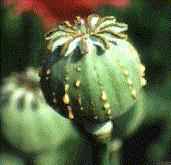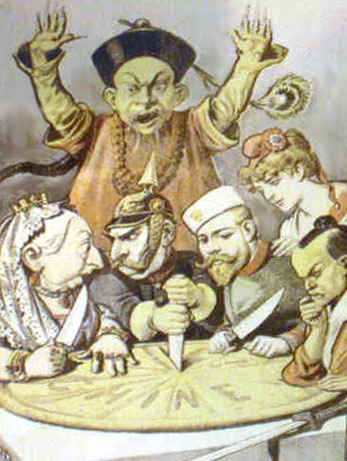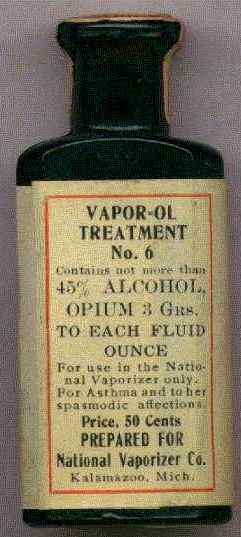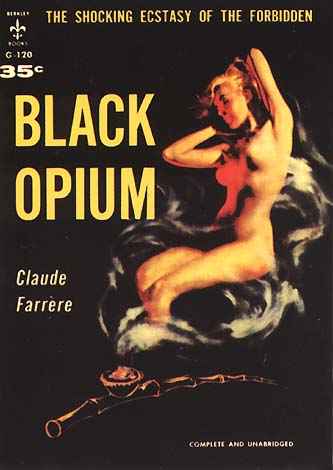|
Opium In the history of mankind, there have only been a few commodities with the power to single-handedly change the course of nations. Among those few, three stand head and shoulders above the rest: sugar, oil and opium.
In the history of mankind, there have only been a few commodities with the power to single-handedly change the course of nations. Among those few, three stand head and shoulders above the rest: sugar, oil and opium. Whether legal or illegal, opium is by far the most successful drug in human history. Over the course of centuries, opium has touched more people than aspirin. Opium has inspired great art and literature, provoked wars and funded terrorists. Opium has been cultivated for its narcotic effects since the earliest days of recorded history, and even today, it's a huge component of mainstream medicine and the recreational mind-fuck market. Derived from the poppy flower, opium is usually harvested as a resin extracted from the plant's seed pods. The resin can then be smoked or consumed in its raw form, or processed for intravenous application.
The poppy was first grown in Sumeria, the Mediterranean, Europe and the Near East. The Ancient Greeks were big fans of the drug. In the Odyssey, Homer describes a drink commonly believed to be an opium-based concoction:
Then Helen, daughter of Zeus, turned to new thoughts. Presently she cast a drug into the wine whereof they drank, a drug to lull all pain and anger, and bring forgetfullness of every sorrow. Whoso should drink a draught thereof, when it is mingled in the bowl, on that day he would let no tear fall down his cheeks, not though his mother and his father died, not though men slew his brother or dear son with the sword before his face, and his own eyes beheld it.Now that's good stuff. Homer was one of the earliest literary advocates of opium, but he was hardly the only one. Over the course of centuries, some of the greatest names in literature would sing the praises of opium, and many credited their work to the drug. The roster of creative luminaries who used straight-up opium, to greater or lesser degrees, included Charles Baudelaire, Samuel Taylor Coleridge, Oscar Wilde, Edgar Allen Poe, Elizabeth Barrett Browning, John Keats, Bela Lugosi, William Burroughs, Jean Cocteau, Arthur Conan Doyle, Billie Holliday, Pablo Picasso and Percy Shelley. And that's just opium. We haven't even begun to talk about the poppy's refined derivatives yet, including heroin, morphine, and laudanum.
Another Frenchman, actor Antonin Artaud, credited his creativity rather creatively to the absence of opium. "It is not opium which makes me work but its absence, and in order for me to feel its absence it must from time to time be present." British author Thomas De Quincey wrote one of the most famous tracts about the glories of opium, Confessions of an English Opium-Eater, published in 1822. The book is a length poem to opium's splendors, full of rapturous passages describing his experiences with the drug, such as the first time he took it (to treat a toothache): oh! Heavens! what a revulsion! what an upheaving, from its lowest depths, of the inner spirit! what an apocalypse of the world within me! That my pains had vanished, was now a trifle in my eyes:—this negative effect was swallowed up in the immensity of those positive effects which had opened before me—in the abyss of divine enjoyment thus suddenly revealed. Here was a panacea—a (pharmakon nepenthez) for all human woes: here was the secret of happiness, about which philosophers had disputed for so many ages, at once discovered: happiness might now be bought for a penny, and carried in the waistcoat pocket: portable ecstasies might be had corked up in a pint bottle: and peace of mind could be sent down in gallons by the mail coach.As you can see, he kinda liked it. Oh! just, subtle, and mighty opium! that to the hearts of poor and rich alike, for the wounds that will never heal, and for "the pangs that tempt the spirit to rebel," bringest and assuaging balm; eloquent opium! that with thy potent rhetoric stealest away the purposes of wrath; and to the guilty man, for one night givest back the hopes of his youth, and hands washed pure from blood; and to the proud man, a brief oblivion for Wrongs unredress'd, and insults unavenged; that summonest to the chancery of dreams, for the triumphs of suffering innocence, false witnesses; and confoundest perjury; and dost reverse the sentences of unrighteous judges...Well, let's just note that it goes on. And on and on. Aside from promoting excessive verbiage, opium in its most basic form was relatively inoffensive at the physical level. Most of the negative health effects associated with opium use had to do with the fact that the habitual user eventually became obsessed with the drug, much like DeQuincey. A true addict, DeQuincey tried to reduce his opium intake at various points during his life, and he even tried to quit once, for the sake of science and the completeness of his Confessions. He managed to go 90 hours before relapsing. DeQuincey resumed his opium use at a much lower level for a few weeks, but he was obliged to start using it heavily again when he found himself unable to review the final proofs of Confessions. As he explained at the end of the text, DeQuincey had to start using opium again so he could tell people what it was like to stop using opium. (No sacrifice is too great for the furtherance of science.) Opium users like DeQuincey consumed the drug in a variety of forms. The earliest opium users simply ate the seeds and resin of the poppy plant, either by itself or baked into a cake or loaf. The flowers and other parts of the plant could be used for a more subdued rush. Later, users discovered that opium mixed well with other drugs, such as alcohol or nicotine.
In recreational use, the combination of opium and tobacco created a booming industry of opium dens, strange surreal places where smokers of opium congregated to sit steeped in their euphoria. Arthur Conan Doyle wrote one of the most memorable descriptions of an opium den in his Sherlock Holmes adventure, The Man With The Twisted Lip, in which Dr. Watson sets off to rescue a family friend from iniquity: Ordering my cab to wait, I passed down the steps, worn hollow in the centre by the ceaseless tread of drunken feet; and by the light of a flickering oil-lamp above the door I found the latch and made my way into a long, low room, thick and heavy with the brown opium smoke, and terraced with wooden berths, like the forecastle of an emigrant ship."Opium fiends" were often profiled as lean, haggard-looking individuals, mainly because pursuits like eating and grooming seemed insignificant when compared to the pursuit of precious, precious opium.
China banned imported opium, and destroyed a major British shipment, and the Brits responded by invading. China lost. Several years later, more or less the same dynamic broke out between China and the British, who were allied with the French the second time around. China lost again. Around the same time, several significant developments were taking place in the world of opium. In 1803, a German pharmacist invented a method for distilling opium into an immensely more powerful form—morphine. The good news was that morphine was exponentially more effective than raw opium in treating pain and other illnesses. The bad news was that morphine was exponentially more addictive than raw opium, which was (as we have seen) pretty damn addictive in the first place.
Although the new breeds of opium derivatives were insanely more addictive than their predecessor, the entire category of opiates was lumped together, and the public campaign against drugs of all kinds treated them as a single scourge in many cases. In 1914, the U.S. passed the Harrison Narcotics Act, which restricted the possession and use of opium and its derivatives (as well as other drugs) to doctor-prescribed medications only. It was, of course, ridiculous to suggest that drug use was somehow un-American. Benjamin Franklin used opium late in his life, albeit to treat severe pain. George Washington is also said to have believed in flower power, although he may have used it as laudanum, a derivative form. Nevertheless, the 20th century saw a sharp increase in America's drug hysteria, fueled by racism directed against Chinese laborers who had come to the U.S. to help build the railroads and brought their cultural tradition of opium use with them. Many propaganda screeds invoked images of innocent white women lured into depravity in the opium dens of San Francisco and elsewhere. Massive crops of opium poppies are still harvested every year in Southern Asia and South America, for both "legitimate" and "criminal" purposes. One of the most important opium economies in recent decades has been Afghanistan, where even in the middle of the U.S. invasion, farmers produced 3,400 tons of opium for shipment around the world. Under the Taliban, opium exports were even higher. A 2003 study estimated that 75% of the heroin consumed in Europe is extracted from Afghan stocks. Opium and heroin trafficking out of Afghanistan totaled more than $1 billion in 2002. Both before and after the U.S. invasion, opium trafficking is believed to have helped fund al Qaeda and other terrorist groups from around Southern Asia. While the consumption of raw opium is on the decline, demand for the poppy is still incredibly strong, since morphine has become a staple of medical anesthesia. Heroin and its derivatives are still extremely popular among recreational users. Opium may no longer be the "just, subtle, and mighty" drug of popular choice, but it will still be a cash crop for years to come, a fact that is no doubt a source of great comfort to Osama bin Laden, wherever he might be.
|
 Opium was cultivated for its narcotic effects at least as far back as 4,000 B.C., and possibly a lot further. In its least processed form, the drug conveys a sense of peace and contentment, in addition to alleviating pain.
Opium was cultivated for its narcotic effects at least as far back as 4,000 B.C., and possibly a lot further. In its least processed form, the drug conveys a sense of peace and contentment, in addition to alleviating pain.  "Everything one does in life, even love, occurs in an express train racing toward death. To smoke opium is to get out of the train while it is still moving. It is to concern oneself with something other than life or death," wrote Jean Cocteau, the French writer and filmmaker.
"Everything one does in life, even love, occurs in an express train racing toward death. To smoke opium is to get out of the train while it is still moving. It is to concern oneself with something other than life or death," wrote Jean Cocteau, the French writer and filmmaker.  One of the most popular preparations was laudanum, developed in the 16th century, in which opium was dissolved into alcohol as a beverage or tincture. Another hybrid, paregoric, was a combination of alcohol, camphor and opium used to treat diahrrea and persistent coughs. Both these products were given to children and even babies, either to treat illnesses or simply to quiet them down.
One of the most popular preparations was laudanum, developed in the 16th century, in which opium was dissolved into alcohol as a beverage or tincture. Another hybrid, paregoric, was a combination of alcohol, camphor and opium used to treat diahrrea and persistent coughs. Both these products were given to children and even babies, either to treat illnesses or simply to quiet them down.  Opium was so precious, in fact, that nations went to war over it. The most notable of these incidents were the Opium Wars of the 19th Century. The initial war over opium broke out between
Opium was so precious, in fact, that nations went to war over it. The most notable of these incidents were the Opium Wars of the 19th Century. The initial war over opium broke out between  Things took a turn for the worse (or the better, depending on your perspective) with the introduction of
Things took a turn for the worse (or the better, depending on your perspective) with the introduction of 